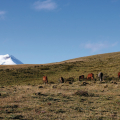COTOPAXIAL NACIONAL PARQUE NACIONAL
Climb to the summit of the world's highest active volcano
It's one of the most popular images of Ecuador! It's best to go there on a clear day, when the sky is clear, to catch a glimpse of the summit of the world's highest active volcano, Cotopaxi. The trail leading to the refuge parking lot, at 4,600 m, winds its way through a desolate páramo. The ascent generally begins at the parking area. From here, you climb gently to the refuge, at 4,800 m. The higher up you go, the thinner the air in your lungs becomes. The more athletic climbers get up there in 30 minutes, the others need more time! Those who suffer from altitude sickness don't always make it all the way. The refuge-restaurant (open all year round) offers around twenty beds and basic comfort. Beyond that, the climb must be made with an experienced guide and appropriate equipment. In this case, you arrive at the refuge the day before the ascent, spend the early part of the night there, and set off for the summit in the middle of the night, around 3 a.m., arriving at the top at daybreak (weather permitting). The best time for such an expedition is between December and January, or in May. From June to September, winds and frost are formidable; in April, rain prevents good visibility. It's essential to use a serious agency. Apart from mountaineers who tackle the summit, a day in the park is sufficient, and you can combine a walk to the refuge with a tour of the Limpiopungo lagoon (allow 1 hour). On a clear day, the volcano is reflected in its waters. Non-motorized travellers or those travelling alone will find a vehicle at the park entrance (US$50 for a 5-hour excursion). You can leave the park by mountain bike. The descent takes around 1 hour. Most accommodations offer this activity. A pleasant ride, but beware of slippery terrain. In August 2015, the volcano awoke after 138 years of dormancy and remains in intense activity to this day, although the park partially reopened in 2020 after several months of closure. The last fumaroles were observed in 2023, after a year of intense activity punctuated by various eruptions of varying magnitude. The strongest known eruption dates back to 1877. At that time, many villages were wiped off the map, killing several thousand people, and ash rains spread as far as Quito. The region's inhabitants all keep abreast of regular seismic developments, so as to react as quickly as possible in the event of another eruption.
Did you know? This review was written by our professional authors.
Book the Best Activities with Get Your Guide
Members' reviews on COTOPAXIAL NACIONAL PARQUE NACIONAL
The ratings and reviews below reflect the subjective opinions of members and not the opinion of The Little Witty.


Nous avons ensuite dormi à l'hostal Tombopaxi, que je conseille fortement.
Très propre, très bon dîner, et vue évidemment sans égal sur le Cotopaxi, si celui-ci n'a pas la tête dans les nuages :)
Nous nous sommes baladés une matinée entière, nous avons vu des chevaux et des lamas sauvages, avec l'impression d'être seuls au monde dans ce beau parc.
Notre moment préféré du séjour!
Je mets la plus petite note possible étant donné, qu'à ce jour, on ne peut pas y aller.